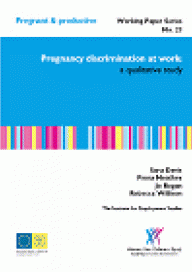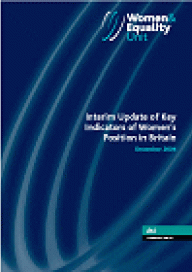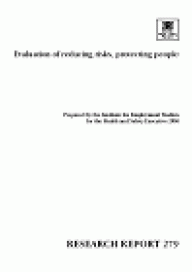Publications
 We author and publish a range of resources to keep you up to date with the latest developments in employment, labour market and human resource policy and practice.
We author and publish a range of resources to keep you up to date with the latest developments in employment, labour market and human resource policy and practice.
All our pdf publications are free to access.
-

Pregnancy Discrimination at Work
A Qualitative Study
Davis S, Neathey F, Regan J, Willison R | Jan 2005 | Equal Opportunities CommissionThe findings of this study into pregnancy-related discrimination illustrate the breadth of issues that come up during working women's pregnancies and the common threads of their experience, in spite of different backgrounds.
-
📄
Pregnant Employees
Good Employer Practice
Robinson D, Newton L | Jan 2005 | Institute for Employment StudiesThis paper aims to: provide recommendations on the basis of current research; highlight the implications for employers; provide a summary of good practice for managing pregnant employees; and give details of how employers can avoid unintentional discrimination.
-
📄
Is Graduate Recruitment Meeting Business Needs?
An Audit of Recruiters' Websites
Hill D | Jan 2005 | Institute for Employment StudiesThis paper presents an audit of graduate recruitment websites that was jointly funded by IES Research Networks and the Council for Industry and Higher Education. Two students, one undergraduate and one postgraduate, conducted the audit to inform the research from graduates' perspectives. The Times Top 100 Graduates Employers polls UK students about who their ideal graduate employers are, then collates and showcases the results in a 'top' 100 ranking of graduate employers by their popularity among students. The web audit used this ranking to explore in more depth the qualities and characteristics of these organisations.
-

Interim Update of Key Indicators of Women's Position in Britain
Aston J, Clegg M, Diplock E, Ritchie H, Willison R | Dec 2004 | Women and Equality Unit, Department of Trade and IndustryIn November 2002, the Women and Equality Unit published Key Indicators of Women's Position in Britain (2002). It provided a set of key indicators across many aspects of women's lives, established benchmarks against which women's progress could be measured over time, and presented factual material to feed into public debate and policy-making. This report provides updates to the tables and figures presented in Key Indicators (2002), using the most recently available data at the time of writing. This publication is no longer available.
-
📄
Building Coaching Capability
Carter A | Dec 2004 | Institute for Employment StudiesThis paper is a short guide for employers. It provides some ideas and help for those who are building coaching capability within their organisations, and those who anticipate doing so. It offers both a framework for employers to determine the best approach to building coaching capability, and case study examples of how First Choice Holidays, the BBC and Inland Revenue have gone about resourcing, deploying and developing their coaches.
-
📄
Researching the Independent Production Sector
A Focus on Minority Ethnic Led Companies
Pollard E, Barkworth R, Sheppard E, Tamkin P | Dec 2004 | Pact/UK Film CouncilThe film and TV industry has a poor record on diversity. There is low representation of minority groups, particularly those from minority ethnic backgrounds, in the workforce, and in content and portrayal. This is a preliminary study that gathers known literature, industry data, expert views and primary data (both quantitative and qualitative) on the independent production sector within both the film sector and the TV sector.
-
📄
A Stepping-Stone to Employment?
An Evaluation of the Permitted Work Rules - Wave 2
Dewson S, Davis S, Loukas G | Nov 2004 | Department for Work and PensionsIncapacity-related benefits provide people who have to stop working because of illness or disability with a measure of earnings replacement. Under the permitted work rules (introduced in April 2002), incapacity-related benefit claimants may work up to 16 hours per week and earn a set amount each week but for a limited period of time only (a maximum of 52 weeks). The research investigated the characteristics and experiences of the people who make use of the new rules; looked at who does and does not make use of the new permitted work rules; explored the extent to which the new rules provide a 'stepping stone' to employment for clients and explored the use of the new rules by Jobcentre Plus staff.
-
📄
Flexing your Remuneration
Variable Pay at Work
Suff P, Reilly P | Nov 2004 | Institute for Employment StudiesVariable pay, sometimes referred to as 'pay at risk', is the portion of the remuneration package that has to be earned on each occasion, usually by meeting and exceeding individual, team or organisational performance criteria. While the rewards from variable pay schemes can be substantial, employees are forced to shoulder more of the business risks - rewarding the 'upside' and penalising the 'downside' of performance.
-
📄
Current Thinking on Managing Attendance
a Short Guide for HR Professionals
Hayday S, Rick J, Patterson M, Turgoose C | Nov 2004 | National Audit OfficeThis publication is no longer available. This best practice guide by the Institute of Employment Studies and the Institute of Work Psychology summarised the thinking and related evidence on the efficacy of various approaches to managing attendance from academic and practitioner literature from the early 2000s.
-

Evaluation of Reducing Risks, Protecting People
Rick J | Oct 2004 | Health and Safety ExecutiveReducing Risks, Protecting People (R2P2) is the document that explains the basis for the Health and Safety Executive's (HSE's) decision-making processes. As such it underpins all HSE regulatory activity. The research summarised here sought to establish the reach of the document amongst the HSE's stakeholder groups and to determine the extent to which R2P2 makes HSE activities transparent and lays the decision making process open to scrutiny.
